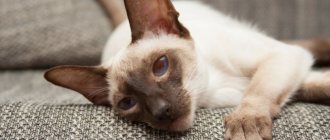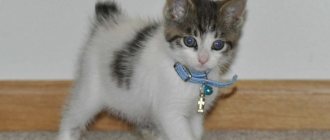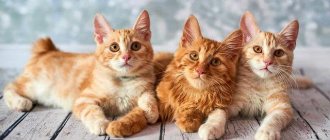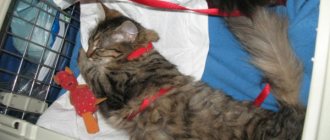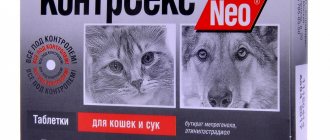Origin story
The Mekong Bobtail is both a new and a very ancient oriental cat breed. A manuscript depicting a Siamese-type cat dates back to the 14th century and is kept in the Bangkok Museum, meanwhile, the breed was officially approved only in 2004, but first things first.
There are many legends associated with Siamese cats in their historical homeland. One of them says that for many centuries, animals with blue eyes and dark faces lived in palaces, guarding treasures and accompanying princesses on walks. A special role was given to cats with curled tails. While swimming, the girls took off their jewelry and hung it on their tails; due to their special structure, rings and earrings did not fall to the floor and were not lost.
The history of the development of the Mekong Bobtail breed is closely connected with the origin of Siamese and Thai cats. For the first time, native cats from Siam came to Europe at the end of the 19th century. In 1884, they were brought to England by an official of the British consulate in Bangkok, Suen Good. The ambassador claimed that the king of the overseas state himself gave him the pair. Around the same time, the first cats arrived in America, traveling from modern Thailand across the ocean to the New World. Many of these animals had kinks and hooks on their tails, which were a sign of royal cats, but breeding work followed the path of culling animals with “flaws.” Perhaps this distinctive feature and separate breed would have been lost if not for the enthusiasts (in particular from Russia) who have been supporting the population for many years.
In addition to those first Siamese, many more bobtails were exported from the countries of Southeast Asia. Short-tailed purrs are a common sight there. In general, the modern name emphasizes their origin Mekong - a long river of the Indo-Chinese peninsula that flows through different countries:
- Burma;
- Laos;
- Vietnam;
- Cambodia;
- part of China and Thailand.
The ancestors of many modern lines were brought from these countries.
In the process of working on the breed, breeders had to add animals with short tails of unknown origin to the breeding, but they first underwent strict selection. There is an opinion that Thai cats with creases on their tails took part in the breeding of the Mekong, but large clubs claim that such matings were not done because they were unjustified. The kittens born as a result of such crossing did not correspond to the given type at all. Today, any interbreed matings for Mekong Bobtails are prohibited.
The first standard for the Thai Bobtail breed (that’s what the Mekong was previously called) was developed by a breeder from St. Petersburg, Olga Sergeevna Mironova. Thanks to her many years of work, it was approved at a seminar of felinologist experts on indigenous cat breeds in December 1994 and was only slightly adjusted at a meeting of the board of felinologist experts in Moscow in 1998.
The presentation of the breed took place in 2003 at the International Exhibition, which was organized by Royal Canin. 30 animals from different breeding lines were presented. A year later, the name was changed to Mekong Bobtail to avoid confusion with the Thais.
Today, more than 300 Mekongs are registered by clubs in Russia, Latvia, Belarus, Germany and Poland. The bulk of the livestock is located in Russia, in particular in the Korgorushi club. Other well-known clubs of this breed include:
- Bast (Kursk);
- Kotofey (St. Petersburg);
- Triumph (Tver);
- Aurinko (Petrozavodsk).
Breed standards
Until 2000, all point bobtail cats were called Thai. In 2003, this breed was officially recognized internationally. And in 2004 in Germany it received the name Mekong bobtail. The breed standard corresponds to the Thai cat, only without a tail. Therefore, it is sometimes called the Mekong Thai Bobtail . It must meet the following parameters:
- usually exactly repeats the Thai pointing color;
- The “broken” short tail consists of several vertebrae; according to the standard, three are allowed. The total length of the “pompom” should be no more than ¼ of the body length. The first “bending fracture” must be at the base of the tail;
- the head is round, the upper part is almost flat, the size of the head is proportional to the body, the chin is clearly defined;
- the eyes are large, oval, blue or blue, slightly elongated towards the temples in an oriental manner;
- the nose is straight, with a hump;
- the ears are wide, set high, with thick bases and rounded ends;
- medium size, body without weights, legs ending in thick rounded paws;
- soft, short wool has no undercoat, its presence is considered a breed defect;
- The female weighs from 3.5 kg, the male can reach 5 kg.
Pros:
- Good hunters, their character does not change with age.
- Temperament is playful and affectionate. They love company, warmth and walks.
- Not susceptible to genetic diseases.
- They live long enough.
Minuses:
- Kittens are expensive.
- It is difficult to find a decent nursery.
- The rarity of the breed, the difficulty of finding a pair for “marriage”.
The price of a Mekong Bobtail kitten is from $200. A cat is more expensive than a cat. The price is also influenced by the popularity of the nursery, pedigree, color, veterinary care and many other factors. The cost of a top-class purebred animal can reach $700 or more. Important advice: when choosing a Mekong Bobtail nursery , be sure to check the number of awards, documents, and look at reviews about it.
Appearance and standards
Mekongs are unique, short-haired, medium-sized point cats with an elegant build and a short tail in the form of a tassel or pom-pom. Males are much larger and more powerful than cats, weighing on average 3.5-4 kg, while cats weigh no more than 2.5-3 kg.
Head and muzzle
The cats' head is smoothly contoured, almost flat on top. The oval shape of the muzzle is emphasized by the heavy lower jaw and chin. The ears are laid back slightly, set high, wide at the base with slightly rounded tips. The eyes are large and expressive. A characteristic feature is a more rounded lower eyelid, which indicates a close relationship with other Thai cats. In general, the cut can be called slightly slanting. Only one color is allowed - intense blue.
Body
Mekong has a strong, muscular and at the same time graceful body of medium size. His back is straight and slightly arched towards the croup. Cats have long legs with soft, oval-shaped pads. A notable feature of appearance, in addition to the tail, is that the claws on the hind legs do not retract completely, therefore, if the cat walks on a hard surface, for example, on laminate, a specific clicking sound is heard when walking, which is not typical for cats of other breeds.
Tail
The tail is short and broken, its length is at least three vertebrae, but should not exceed ¼ of the body length. The first break should be at the base of the tail. Externally, the creases may not be visible, but they must be felt through the skin. The bobtail tail is not only a distinctive feature of the breed, but also a kind of “passport” of each animal, because no two tails are identical. Each one is unique in its own way with unique curves, kinks and lengths. By the way, there are no long-tailed Mekongs.
Coat and colors
The soft, short fur lies tightly to the body. It is beautiful and shiny, pleasant to the touch with minimal undercoat. This type of fur is often compared to mink. Another feature of the Mekong is that its skin does not adhere firmly to the muscles and is pulled much stronger than that of other cats, not only at the withers, but almost throughout the body.
For Mekong Bobtails, any point (Siamese) colors without white spots or markings are allowed. The most common:
- blue point;
- tabby point;
- red point;
- tabby point.
Catering
Mekong Bobtails have a special diet. Meals are fractional (due to the special internal structure). They never overeat, so access to food can be unlimited.
Natural products
Bobtails are big meat eaters. Turkey, veal, rabbit, beef, lamb - they won’t refuse anything. But they don’t like chicken. Do not offer pork, quail and duck: firstly, parasites are often found in this meat, and secondly, it is too heavy for the stomach. There is no need to cook the meat: just keep it in the freezer for a day and, after taking it out, pour it over with boiling water. They give it every day.
Bobtails also eat fish. You should not give freshwater (it accumulates toxins), only seawater: pink salmon, taimen, salmon, trout, hake. The bones are removed and the pulp is stewed. It is allowed to give no more than once a week (otherwise the cat will develop kidney problems).
Be sure to add vegetable oil to your food (half a teaspoon per porridge). Fermented milk products are given 3-4 times a week. Natural yogurt, fermented baked milk, low-fat sour cream, cottage cheese, and cream are rich in calcium and are quickly absorbed. 4 times a week - one quail egg (raw, not boiled). Chicken eggs only produce the yolk.
It is advisable to give porridge every other day. Oatmeal, rolled oats, millet, rice. Many cats love liquid semolina porridge, but while it can be given to babies often, indulge adults with this delicacy only occasionally.
Vegetables will help fill the body's need for fiber and vitamins: beets, zucchini, asparagus, pumpkin, cucumbers, carrots, greens (spinach, green onions, basils, celery). They are fed to the cat every day.
Sprout wheat or oats at home. This is not difficult at all: buy seeds or a special set at a veterinary pharmacy, sow and water the seedlings. And the cat will eat it itself as needed.
The cat should have water in its bowl at a comfortable drinking temperature (not hot, but not cold) freely available and at any time of the day. Tap water cannot be poured: be sure to boil it or pass it through a purifying filter. Every morning and every evening, wash the bowl and fill it with fresh liquid.
Mekong Bobtails should not be given the following foods:
- Tea, coffee, juices, alcohol, mineral water;
- Baked goods (bread, buns, cakes, waffles, cookies);
- Ice cream, yoghurts with colored and other additives, snowballs;
- Frankfurters, sausages, sausages, ham, canned food for people;
- Fat, trimmings, bones, skin, lard;
- Seasonings, pastes and sauces;
- Potatoes, cabbage, legumes and peas;
- Milk for individuals older than 4 months.
Expert opinion
Dusheba Vera Ivanovna
In 2010, she graduated from the Moscow State Academy of Veterinary Medicine named after K.I. Scriabin with honors, specializing in veterinary medicine. I regularly attend veterinary conferences, congresses, and webinars.
When creating a menu for your favorite tailless, consider its age (kittens and adolescents need to get more calories), temperament and health problems. You cannot feed alternately natural and industrial food! It is only permissible to replace dry food with wet food from time to time, but of the same brand.
Pictured are kittens of the Mekong Bobtail breed.
Recommended food
Economy and premium feeds are poor in composition, often cause allergic reactions and are poorly digestible; you need to choose them individually. More balanced composition in super-premium and holistic foods: Innova, Acana, Sanabelle, Duke's Farm.
Below are recommended premium and holistic foods; links with food names are clickable. Using them, you can, within our website, read descriptions of food and read reviews from owners of the Mekong Bobtail cat breed.
| Super premium | Super premium | Super premium |
| Vet Life | Nature Life | Arden Grande |
Character
Mekong Bobtail cats are distinguished by their balanced temperament and special intelligence; they are friendly and sociable. Very often they are compared to dogs. And indeed these two animals have a lot in common in behavior. Mekongs walk calmly on a leash, are smart enough to remember house rules and simple commands, love to carry different things in their teeth and fetch objects, they constantly accompany their owners, use their teeth rather than claws in fights, and express their range of emotions with their tail.
Like many other representatives of the eastern group, they are quite talkative, but unobtrusive. With all its appearance and habits, the Mekong shows that it belongs to the high society of cats of blue blood - they are proud, stately and independent.
The Mekong Bobtail is equally suitable for large and small families, as well as single people.
You can safely take such cats with you on a trip or for a walk, without worrying about them getting lost. Pets prefer to be close to their owner. In addition, cats treat small children well and endure many manifestations of children's love with angelic patience. Mekongs usually get along well with other animals in the house and never create conflict situations.
Features of character and behavior
The Thai Bobtail breed is characterized by atypical behavior, a bit like that of a dog. In Thailand, cats lived in temples, playing a kind of guard role. The character was passed on to descendants genetically, which is why Mekong cats have a deep attachment to their home and owners. The bobtail actively responds to the call, quickly runs up to the door and sniffs visitors. Guests who look unattractive to cats receive hissing and dissatisfaction. However, these pets show love quite willingly.
It is commonly believed that the Siamese cat is self-sufficient and does not require company, but this is not so.
Mekong Bobtails are social animals that communicate a lot and do not like to be alone.
After the absence of the owner, cats want to show their affection, they follow all the actions of a person, poking their mustachioed muzzle everywhere. Pets spend a lot of time in the kitchen, watching the cooking, trying to steal a piece of food. Females have a more active character, while males are phlegmatic and calm.
The Mekong Bobtail is loyal to children, stoically enduring pranks, but does not tolerate violence and pain. Aggression for no reason is not typical for these cats, but the pet can stand up for itself.
The hunter's instinct is quite strong, so the breed perceives birds, rodents and fish only as prey. But the bobtail gets along well with dogs and cats.
Content
Mekong Bobtails are great for apartment living. They calmly tolerate loneliness, practically do not shed, are clean and tidy, without a specific smell. Adult cats very rarely mark corners. Perhaps little kittens will cause a little trouble with their irrepressible energy and activity, but as they grow older they will become more serious and balanced, but by no means lazy.
Mekongs reach puberty very early, many by 4-5 months. It is important for owners of several cats not to miss this moment and to prevent accidental matings of young and fragile animals.
Mekong Bobtail cats retain their sexual activity until old age. It’s interesting that when kittens are born, cats take over the mother’s function, that is, they lick the babies, teach them to use the toilet, feed them, etc. So, if you have a pair of Mekong Bobtails, then matriarchy will reign in your home. The cat, in turn, takes upon itself only one responsibility - to feed, and carefully ensure that “dad” fulfills all his upbringing responsibilities. In addition, representatives of the “female half” behave more independently, and in their behavior strongly resemble an eastern princess.
Interesting Facts
- These cats have matriarchy. If you have purchased two kittens of different sexes, the owner will always be a cat. She will dominate, even if she is smaller in size.
- It is interesting that they meow only when communicating with a person; they do not make such sounds among themselves.
- Mekongs are sensitive to sharp sounds. If the TV is loud in the room and music is playing, they leave the room. Therefore, having got such a cat, you will inevitably live in peace and quiet.
- Blue-eyed cats see worse in the dark than their relatives with yellow or green eyes. They have almost no reflective pigment in the taptum (layer of the retina). Therefore, in the dark, the eyes of such pussies do not glow, reflecting the flash. You are unlikely to get the “burning eyes effect” in the photo.
- There are amazing stories when these furry friends protected their owner from a dog and even a snake. Most likely, such skills are rooted in their storied past. Mekongs are considered descendants of sacred temple cats. And they were hired there not only for their beauty and intelligence, but also for their courage. In addition, they have a peculiarity in their physique - the skin does not fit tightly to the subcutaneous tissues. Therefore, the bites of snakes, which often crawled inside the temple, fell where there were no blood vessels. Moreover, the cat itself could injure the snake with its teeth. She circled around the reptile for a long time, exhausting it, and when it lost its vigilance, it bit the neck.
Care
Representatives of this breed do not require special care. It is enough to comb them 3-4 times a month to remove dead hairs. Brush a little more often during the molting period and only in order to reduce the number of hairs left on things or furniture. It is not recommended to bathe the Mekong often. Many owners resort to water treatments only before exhibitions.
The ears are periodically inspected and, if necessary, cleaned with a special lotion. As a rule, there is no need to clean the eyes. Cats wash themselves on time and are not prone to excessive tearing, and therefore their tear ducts remain clean without owner intervention.
Care and maintenance
The Mekong Bobtail is extremely easy to keep. Its short, smooth coat has virtually no undercoat, and shedding goes unnoticed. It is enough to brush your pet with a soft massage brush once a week. It is worth purchasing a scratching post for your cat, but you can trim the claws on the back paws by hand. The procedure must be carried out very carefully so as not to damage nearby vessels.
To prevent tartar, you can give your bobtail special solid food. Bathing is optional for this breed, but some cats love water. Bath procedures should be carried out no more than twice a month. If the fur becomes dirty, veterinary wet wipes can be an alternative. Mekong cats are clean, usually do not mark territory, and easily get used to being walked on a leash or on the owner’s shoulder. In the cold season, you should not abuse air baths - bobtails are heat-loving.
The diet should be balanced. It can consist of natural products or premium food. It is not recommended to give milk, liver, pork, cabbage, beets, cod and pollock, food “from the table”. When choosing natural food, make sure that the menu includes vegetables and cereals (15-20% of the diet). Lean meat and dairy products are allowed. Once a week you can treat your pet with a quail egg or fish. In general, Mekong Bobtails are not picky in terms of food. The breed is not prone to obesity; it is enough to feed an adult animal twice a day, providing access to clean water.
Diet
Each cat is individual, this must be taken into account when deciding the issue of feeding. Animals that are not picky can be fed natural food, providing them with a complete diet, in which, in addition to meat and offal, 15-20% should be cereals and vegetables. Once a week you can give fish and a quail egg. It is not recommended to feed cats “from the table”.
Remember that milk is only beneficial for kittens up to 2-3 months old. With age, the ability to digest lactose decreases markedly, and sometimes disappears altogether.
If for some reason it is impossible to organize a balanced natural diet, you should give preference to ready-made food. It is worth considering that this must be complete food of at least premium class. Also, when choosing food, it is important to take into account the physiological characteristics of the animal:
- age;
- pregnancy period;
- lactation and so on.
How to choose a kitten
When choosing a Mekong Thai Bobtail kitten, you should rely on the following characteristics:
- the body is strong and toned;
- paws of medium size, dense;
- nose with a small hump;
- large oval-shaped eyes;
- tail with an obligatory fracture at the base.
Kittens may be white at birth; the point coloring begins to appear only at one year of age.
The kitten should be curious and playful, moderately well-fed.
This indicates that the pet is healthy.
You should purchase an animal only from nurseries with a good reputation.
Mekong Bobtail cats are considered a fairly rare breed.
Because of this, their prices are too high.
The cost depends on criteria such as the sex of the animal, the presence or absence of CSU documents, etc.
Depending on this, the price varies between 10-50 thousand rubles.
If a pet is purchased for breeding, you should take an animal with a pedigree.
If you are buying a pet for yourself, you can consider cheaper options.
Important! When purchasing a Mekong Bobtail kitten, ask the breeder for a passport with vaccinations.
Health and life expectancy
The Mekong Bobtail is a native breed, so its representatives enjoy excellent health. But this does not mean that they do not need to be shown to doctors for a preventive examination, vaccinated and periodically driven away from parasites.
There are a lot of cat diseases that Mekong cats can contract at any time. Monitor their behavior, and if you think that your pet is behaving strangely, is starting to feel sad, or is refusing to eat, be sure to show it to a specialist. Remember that any disease is best treated at the initial stage.
Mekong Bobtails are rightfully considered to be long-lived; for them, 20 years is not the limit. Interestingly, until old age they remain sexually active and are capable of childbearing. For example, the cat from the Korgorushi cattery Mars is a real sex symbol of the cat world; he became a father the last time when he was 23! And a cat from the same cattery named Conchitta gave birth to a litter at the age of 22!
Advantages and disadvantages
A purebred Mekong or Thai bobtail has a number of advantages:
- The calm nature, which is especially pronounced in males, makes pets obedient.
- Requirements for care and maintenance are low, which is not typical for exotic breeds.
- Absence of a large amount of hair falling out, even during shedding.
- Innate loyalty allows Mekong Bobtails to be kept with other cats or dogs.
- Animals show a significant degree of tolerance towards children.
- Cats are loyal to their owner and spend a lot of time together.
- Lack of susceptibility to congenital genetic diseases.
- The life expectancy of the Thai Bobtail is one of the highest among cat breeds.
The Mekong variety of short-tailed cat also has disadvantages:
- The breed is quite loud, often meowing in different tones.
- The quality of wool depends on a diet rich in minerals.
- High activity of kittens and young females.
- The difficulty is in finding a purebred Mekong kitten.
- Impossibility of keeping with birds or rodents due to the developed hunting instinct.
Choice of kitten and price
If you are thinking about buying a kitten of this breed, then first of all you need to decide on a nursery and read reviews about certain breeders. The breed is not the most common, and therefore kittens may have to wait a little and be booked in advance.
Mekong babies will be ready to move to a new home only at three months. It is worth considering that they are born almost white. Characteristic darkening in certain areas of the body begins to appear only from two to three months and is finally formed by the age of one, and sometimes later. Kittens must be healthy and well-groomed, with shiny fur, clear eyes and an excellent appetite.
The average cost of a Mekong Bobtail kitten is 15-20 thousand rubles.
The following factors influence the final cost:
- appearance of the kitten;
- place of purchase;
- availability of documentation.
If you are not sure that you can choose a good baby on your own, it is better to seek help from a breed specialist.
You can often find more affordable options on the Internet. As a rule, “hands-on” kittens without documents cost much less, about 5 thousand rubles.
Mating of Mekong Bobtail
Like any oriental cat, the Mekong is characterized by early puberty and special sexuality. Therefore, you should not be surprised when a little six-month-old bobtail girl suddenly goes into heat.
Of course, at this age the cat is not yet ready to become a mother; technically this is possible, but the offspring from a young mother are unlikely to be viable. Indeed, physically, the pet itself is still a kitten, and physical maturation and puberty are two different things.
Felinologists recommend waiting up to 10 months to mate. By this point, the animal’s body will have matured, and the cat will be ready to give birth to full-fledged offspring without risk or complications for its health and the life of the kittens.
Cases vary, sometimes the Mekong Bobtail can be mated at a younger age - 7-8 months. This is necessary if the cat has early, recurring heats. In such cases, pregnancy is necessary to maintain the health of the animal. But in any case, preliminary consultation with a veterinarian and agreement with the club are required.
In standard situations, one or two heats are missed, but no more than three, because a long delay is another threat to the health of the pet. You should not abuse drugs that stop or suppress estrus. If they are used frequently, the effectiveness of the drug decreases. In addition, hormonal disruptions begin in the animal’s body, as a result the cat can become seriously ill.
Mekong Bobtail – owner reviews
Who can you trust to judge the breed if not the owners and connoisseurs of the Mekong Bobtail? For many people thinking about choosing a pet, reviews of cats are of great importance in making the final purchasing decision.
Personally, I think the Mekong is an excellent breed, and the reviews I picked up were positive (in principle, there were no very negative ones).
- Olga. Korolev.
We have known bobtails for a long time. My son turned 10 when we bought our first cat. How we loved her, and how she loved us. She followed us and slept next to us. Now my son is 25 and recently he bought a copy of our first Sonechka. It feels like Sonya has returned, just as affectionate, purring at her side, lying next to her. Do you know how she feels when she’s bad, she understands everything, we adore her. She recently gave birth, she has four kittens, she is caring, and now everything revolves around them.
- Marina. Saint Petersburg.
I bought the bobtail purely for myself, not for divorce. In fact, I even saved money on this. What can I say - smart, sociable, intelligent. So I adore him, but sometimes his loudness is out of place, but otherwise everything is fine.
These were reviews of the Mekong Bobtail breed. Maybe they will to some extent help you make a decision about buying a pet of this breed or, on the contrary, will make you think about your future choice. The point of publishing reviews is not to highlight the pros and cons of bobtails. The main thing is that people are interested in these cats and are ready to share their attitude towards them, which means that the breed definitely has a future.
Mr. Cat recommends: character
Representatives of this breed are extremely sociable and loving, and they do not single out one person in the family, but show signs of attention to all family members.
Kittens quickly get used to their new owners. They feel comfortable living both in an apartment and in a private house. Thanks to the love for walks, you can take them with you when going out into nature and to the countryside. They can walk on a harness like dogs or run alongside without a leash.
Mekongs love to hunt and often bring dead mice or birds from walks, this is how they show their love and devotion to people.
Due to the similarity of character to dogs, they get along well with them and play, entertaining each other. Therefore, if the family already has one, you can safely get a Mekong, together they will not feel sad in the absence of their owners.
High intelligence helps in training a pet; it will easily get used to a new place of residence and quickly learn the rules accepted there. There are no problems in training to use a scratching post and a tray.
